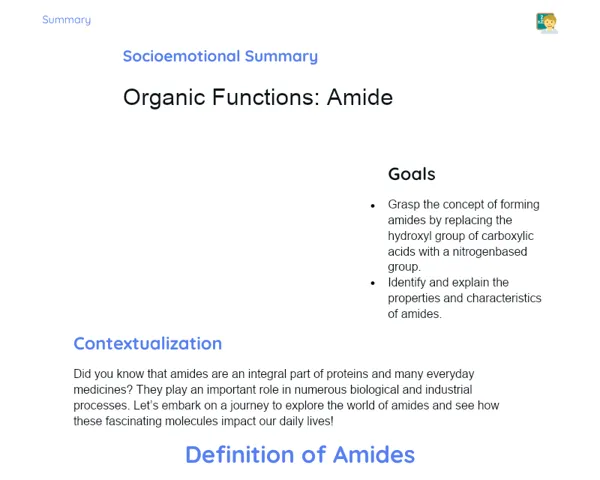Goals
1. Understand what aldehydes are and their structural characteristics.
2. Differentiate aldehydes from ketones based on their chemical structures.
3. Indicate the physical and chemical properties of aldehydes.
4. Relate the properties of aldehydes to their applications in the job market.
5. Identify examples of aldehydes in everyday life and various industries.
Contextualization
Aldehydes are organic compounds that are commonly found in our everyday lives and are vital in various industries. From the delightful fragrance of vanilla to the production of plastics and resins, aldehydes are crucial for many items we encounter daily. Grasping their structures and properties is key to applying them effectively and creatively in the job market. For instance, formaldehyde is a straightforward aldehyde that is utilized in manufacturing construction materials, sanitizers, and personal care items. Benzaldehyde, on the other hand, finds extensive use in the perfume and food sectors due to its appealing scent.
Subject Relevance
To Remember!
Definition and Structure of Aldehydes
Aldehydes are organic compounds defined by the presence of the formyl functional group (–CHO). This group is consistently located at the terminal end of the carbon chain, which sets aldehydes apart from other types of organic compounds, like ketones, where the carbonyl group (C=O) is found in the middle of the chain.
-
Aldehydes have the formyl functional group (–CHO).
-
The formyl group is always at the terminal position of the carbon chain.
-
Aldehydes differ from ketones, which have the carbonyl group situated in the middle of the chain.
Differences between Aldehydes and Ketones
While both aldehydes and ketones contain the carbonyl group (C=O), their placement within the carbon chain distinguishes them. In aldehydes, the carbonyl group is connected to a hydrogen atom and a carbon chain, whereas in ketones, the carbonyl group is bonded to two carbon chains.
-
Aldehydes have the carbonyl group linked to a hydrogen and a carbon chain.
-
Ketones have the carbonyl group connected to two carbon chains.
-
The position of the carbonyl group influences the physical and chemical properties of both compound types.
Physical and Chemical Properties of Aldehydes
Aldehydes showcase specific physical and chemical properties due to the formyl group. Typically, they exist as liquids or solids with low melting and boiling points. Chemically, aldehydes are reactive, undergoing oxidation and reduction, and participating in nucleophilic addition reactions.
-
Aldehydes generally possess low melting and boiling points.
-
They are reactive substances that can be easily oxidized or reduced.
-
Their ability to participate in nucleophilic addition reactions stems from the carbonyl group.
Practical Applications
-
In the fragrance industry, benzaldehyde is used to create almond-like aromas.
-
Formaldehyde is widely utilized in the production of building materials such as resins and plywood.
-
Vanillin, an aldehyde, is a popular flavoring agent in the food sector, especially in sweets and confectionery.
Key Terms
-
Aldehyde: Organic compound with the formyl functional group (–CHO).
-
Ketones: Organic compounds with a carbonyl group (C=O) linked to two carbon chains.
-
Formyl Group: Distinctive functional group of aldehydes, consisting of a carbon atom linked to a hydrogen atom and a carbonyl group.
-
Oxidation: A chemical process wherein a compound loses electrons, typically increasing the number of bonds with oxygen.
-
Reduction: A chemical process in which a compound gains electrons, usually reducing the number of bonds with oxygen.
Questions for Reflections
-
How does the chemical structure of aldehydes affect their properties and industrial uses?
-
What safety measures should be followed when handling aldehydes in a lab environment?
-
In what ways can understanding aldehydes aid in the development of innovative chemical products in the market?
Investigation of Aldehydes in Daily Life
This mini-challenge provides students with the opportunity to leverage their knowledge of aldehydes by identifying and analyzing the presence of these compounds in everyday products.
Instructions
-
Select three products you have at home that may contain aldehydes (e.g., perfumes, cleaning agents, flavored foods).
-
Investigate the chemical composition of these products and pinpoint potential aldehydes present.
-
Discuss the properties of the identified aldehydes and elucidate how these properties influence the functionality of the product.
-
Prepare a brief presentation (3-5 minutes) to share your insights with the class.



